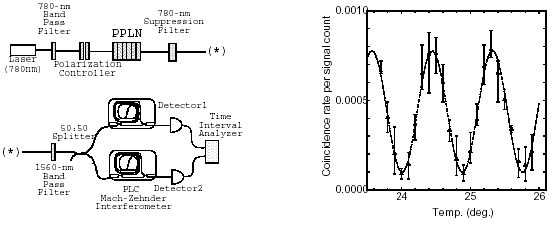@
Toshimori Honjo1, Hiroki Takesue1 and Kyo Inoue2
1Optical Science Laboratory, 2Osaka University/NTT Research Professor
@The generation of entangled photon pairs in the 1.5-µm telecom
band is essential for quantum communication over optical fiber networks[1,
2]. In this paper, we report the generation of 1.5-µm band energy-time
entanglement using a periodically poled lithium niobate (PPLN) waveguide
and a two-photon interference experiment using a planar lightwave circuit
(PLC) [3].
@Figure 1 shows the experimental setup. A continuous wave light from a
laser diode with a wavelength of 780 nm was used as a pump light. The light
was polarization controlled and then launched into a PPLN waveguide. Frequency
degenerated photon pairs were generated in the PPLN at around 1560 nm by
the spontaneous parametric down conversion process. After the PPLN, the
light was filtered to suppress the 780-nm pump light and was also filtered
by a 1560-nm band pass filter to reduce the dispersion in the PLC interferometer.
The entangled photon pairs were launched into a 3-dB fiber coupler, which
separated the signal and idler with 50% probability. The signal and idler
photons were launched into a planar lightwave circuit (PLC) Mach-Zehnder
interferometer. The phase difference between the two paths was precisely
adjusted by controlling the temperature of the interferometer and stable
operation was possible. Photon detectors based on an InGaAs APD were set
at each output of the Mach-Zehnder interferometer. The output signals of
the photon detectors were input into a time interval analyzer (TIA) to
measure the coincidence. We used this setup to perform a two-photon interference
experiment. In this experiment, we fixed the temperature of the PLC interferometer
for the signal and changed that for the idler, and measured the coincidence.
@Figure 2 shows the experimental results. The triangles indicate the experimentally
obtained coincidence rate per detected signal photon for each temperature.
The count rate of each detector was `1700 cps throughout the measurement.
Although the count rates remained, we observed a deep modulation of the
coincidence rate as we changed the temperature. We obtained coincidence
fringes with 77.3% visibilities without subtracting the accidental coincidences.
Considering both the estimated average number of photon pairs per gate
of 0.12 and their Poisson distribution, the visibility of the setup was
theoretically estimated to be 77.4%, which means energy-time entanglement
was confirmed and very few noise photons were generated by the pump light.
[1] I. Marcikic et al., Phys. Rev. Lett. 82 (1999) 2594.
[2] H. Takesue et al., Phys. Rev. A 72 (2005) 041804(R).
[3] T. Honjo et al., CLEO/QELS 2006 (2006) JTuA5.
 |
|
| Fig. 1. Experimental setup. | Fig.2. Coincidence fringe. |